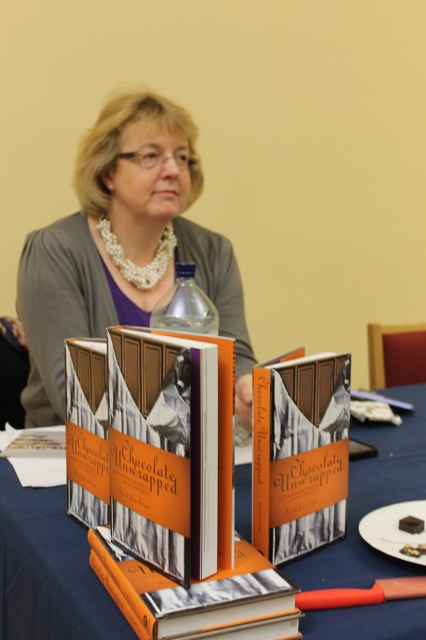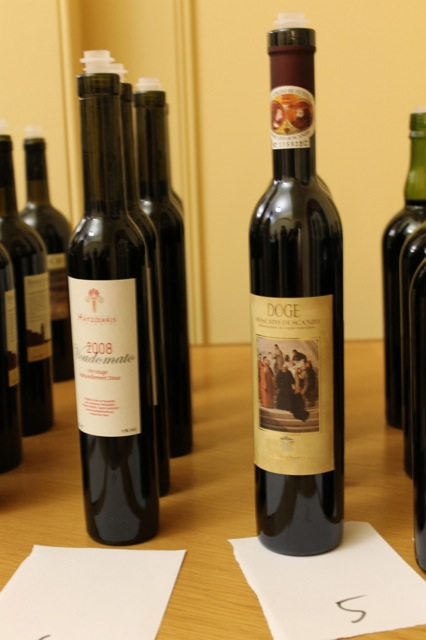
To taste 10 rare and unusual wines in an evening is a treat. To taste them alongside a selection of 12 of the world’s finest chocolates was a joy. To be tutored in our tasting of both the wine and the chocolate by the ever erudite, charming, and approachable Sarah Jane Evans approached the sublime.
On this, her third visit to the Club, Sarah Jane – who sadly was struggling with the beginnings of a cold – introduced us to the rituals and techniques of chocolate eating, using a Valrhona Manjari 64% to illustrate her points. ‘First appearance, then nose, then palate.’ Remind you of anything? Yes, there are indeed a lot of commonalities between the approach one should take to chocolate and to wine. (However I have yet to listen to a glass of wine in order to identify the quality of its ‘snap’!) As both the founder of the Academy of Chocolate, and the author of ‘Chocolate Unwrapped’, a guide to tasting and enjoying the world’s finest chocolate, Sarah is a fount (ain?) of information about the origins of the cacao bean and the various stages of its transformation into chocolate. A process that Sarah Jane described as more complex than winemaking.
In between regaling us with anecdotes about the clonal varieties, conching techniques and the social issues that bedevil many areas of cacao production, Sarah Jane introduced us to the wines in batches of three.
First, a group of three reds:
Bogle Old Vine Zinfandel 2009. To quote the Oak Cliffe Advocate in November 2011 ‘It doesn’t have that cough syrupy sweet fruit that is all the rage. The alcohol isn’t so overwhelming that that you feel it coming out of your nose. What does it have? Enough blueberry fruit to be noticeable, but not so much as to overpower the wine. A beginning and an end, including some very zippy tannins and a little earthiness.’ The wine spends 10 months in American oak and comes in at 14½%.
Mas Amiel, Maury 2008. From one of the region’s top producers, this wine is made from Grenache Noir and grown in the Roussillon area of France on schist. It is made in a lighter and more modern style with the technique is similar to that of port production, the fermentation being stopped by alcohol. On the nose and palate it had ripe sweet black fruits with some tar.
Banyuls Grand Cru Camille Descossy 2003. Named after the fauvist painter who worked in nearby Collioure, this wine is produced in a former Dominican priory. Soft and sweet, with distinct dried fruits and spices on the nose and palate, the wine is from the Banyuls Grand Cru appellation, which was created in 1972. The wines are kept for a minimum of 30 months in either oak barrels, or left outside in the sun in glass containers, to maderise. The resulting wine is robust and long.
How then did our chocolates fare?
To taste alongside these wines we experienced:
Esmereldas Milk with Fleur de Sel, 42%, Original Beans. From an organic producer who plants a tree for every bar sold, the chocolate is produced in Switzerland, conched for around 50 hours and is smooth with a hint of salt to ‘cut’ its creaminess. Sarah Jane noted a note of strawberries and cream but I suspect our palates were not yet attuned to the nuances of chocolate tasting.
Lindt Excellence Roasted Dark Almond. ‘The best of the High Street’ according to Sarah Jane, A good snap, broad creamy flavours.
Trincheras 70%, Rózsavölgyi Csokoládé. Made from Venezuelan beans, the chocolate has a good sheen and the bars are unusually moulded, with a slightly grainy texture and a lingering, complex and almost red wine-like flavour profile.
Of the wines, the Mas Amiel was a hit on our table, with the Esmereldas chocolate my personal favourite – although not necessarily together.
The second group of wines introduced us to:
Hatzidakis Voudomato, Santorini, 2008. Produced in very small quantities, this sweet red passito wine is made from Voudomato grapes (the name meaning ‘bulls eye’, which the grapes apparently resemble). The vines are ungrafted with the producer – described by Sarah Jane as ‘a hero of Greek wine making’ – laying claim to their being 500 years old. Grown on the volcanic, sandy soil of the island, after harvesting the grapes are laid out to partly dry (raisin) in the sun. They are then slow fermented in stainless steel tanks before the wine is aged for five years in old oak barrels. On the nose it was somewhat reminiscent of cough mixture, but on the palate it developed lingering, unctuous rich ripe cherry liqueur flavours.
DOGE, Moscato di Scanzo, La Brugherata 2006. Sadly not available in the UK, this little known wine was donated to the tasting by the producer, for which a huge thank you! The appellation, which was granted DOC status in 2002, became a DOCG in 2009 and is located between Lake Guarda and Milan. It is the smallest DOC area in Italy. Made from the moscato scanzano grape and grown on limestone soil, this is a different style of passito to Wine 4, more floral and longer aged. On nose and palate it was full of roses, stewed red fruits, almost jammy with hints of cinnamon and pepper. It ideally complemented the chocolate and also provided a good match for the cheeses which were served at the end of the evening.
Malamado, Zuccardi, Mendoza 2008. Made by the Zuccardi Family in the Maipu region of Mendoza, Argentina. The estate is considered one of the best run in the region, with a wide range of grapes and wines produced. The first fortified malbec, this wine is aged for two years in oak. The nose and palate produced ripe figs, raisins and prunes, with a long spicy finish. Interestingly the producer suggests it can be used as a cocktail ingredient!

With this group of wines we enjoyed:
Orange Confite 65%, organic, Rococo. One of the first to appreciate the power of good packaging for her chocolates, Chantal Coady has been an innovator of the London chocolate scene since 1983. Creamy, intense chocolate flavour with a hint of orange.
Sea Salt and Hazelnut, Amelia Rope. A bar with the texture on top rather than mixed through. On the palate rich and biscuit like, a real star. Hand made and packaged by the producer herself for our event.
William Curley Dark Muscovado. A chocolate from the UK’s top chocolatier for the past four years. Beautiful to look at, thin dark couverture from one of Italy’s best producers enrobing an intense hit of liquid, unctuous, finger-licking muscavado. Unsurprisingly this chocolate won the best in the UK prize in 2011.
Exhausted, we bravely soldiered on to the next group of wines:
Fontanafredda Barolo Chinato NV. Usually served as a digestif or even an aperitif with soda, this was described by Sarah Jane as a ‘vino di meditazione’ Produced in the Chinato region of the Barolo appellation in Piedmonte, from the nebbiolo grape. After a room temperature fermentation and the introduction of a bittering agent – primarily cinchona bark, the principal ingredient in quinine - the wine is matured in small barrels for up to 12 months. It was famed for its medicinal uses in the 19th century. On the nose, a resin-like aroma reminiscent of freshly chopped pine logs with notes of cinnamon, cardamom and orange peel.
Noval 10 year old Tawny. Now owned by the insurers Axa, who are taking a long view of their investment, this wine is produced from the touriga naçional grape in vineyards that have been substantially rebuilt over the last ten years. Complex on both the nose and palate. On the nose, walnuts and hazelnuts. On the palate, some vibrant young fruits followed by a lingering peppery finish, with the characteristic dried fruit flavours developing throughout.
Noval Black, Douro. A relatively recent addition to the Noval portfolio, the Black replaces the LB Port in Noval’s line up. Aged for two years before bottling. Awarded 90 Parker points – but do we care! This port was a real revelation, with rich deep dark chocolate and raspberry on the nose and palate. (Short pause while I rush out and buy a bottle!)
With our blood sugar reaching dangerous levels and only one friendly GP face in the audience to resuscitate us should be collapse with a collective ‘hypo’, we reached out for the next three chocolates:
Crushed Diamonds, 55%, Chocolate with mild and cacao nibs. From producers Chocolate and Love, founded by a ‘reformed chartered surveyor’ and a lawyer and with one of the best tag lines on their website I have found – ‘Chocolate is nature’s way of making up for Mondays’! Made from ethically sourced organic chocolate. Nibs are an increasingly fashionable ingredient and the bar had an interesting texture. Nutty on the finish.
Maya Gold 55%, Green & Blacks, Fairtrade, Organic. Green & Blacks were the first fair trade producer in the UK, now ultimately owned by Kraft. Kraft has however increased the distribution of G&B products. This chocolate was something of a like/loathe divider amongst those present. A rather granular texture, some spicy orange citrus notes on the palate. Seen by some as the ideal companion for the Barolo Chinato.
William Curley Raspberry Ganache. Another chocolate from the top banana of the UK chocolate world. Made with fresh raspberry paste, which is topped with fresh ganache and thinly coated with a top quality couverture. A perfect match with the Noval Black in my view.
Finally,
Wine 10, Nocturne Sec NV, Tattinger. 30% pinot noir, 30% pinot meunier and 40% chardonnay. Pale yellow, fine persistent mousse, On the nose subtle and with some stone fruits notes. On the palate, soft with pleasing fruit flavours. Long and with a sweet aftertaste, perhaps due to the 20g/l dosage.
Chocolate 10, Cardamom White, 30%, Rococo. Made with cocoa butter, the bar melts quickly in the hand (and of course cocoa butter is widely used in the making of hand cream!). A slight citrusy tang from the cardamom, but long and somewhat cloying on the palate. Perhaps not an ideal match with the Nocturne. Would a sweet wine have balanced the flavours better? Sadly there were none left in my glasses to experiment with.
And to close the evening, ‘just one last mouthful’ - Milk chocolate with pale lime and sea salt, from Amelia Rope. Made from Ecuadorian chocolate imported in buttons, this is new to Amelia’s range. The hint of lime intensifies the sea salt flavour. Perhaps a chocolate margherita would be my closest descriptor! Amelia won a gold medal at the 2011 Chocolate Academy awards for the best flavoured milk bar with this creation.
A unique experience, without any doubt. We at the OWC yet again are in Sarah Jane’s debt for introducing us to so many different wines and a stunning range of chocolates, in her customary endearing and charming manner.
HRE 27.1.12